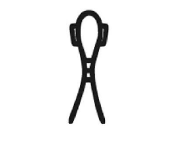SA-symbol means protection
Sa – symbol means protection
Abstract
The ‘Sa’ symbol meant protection in ancient Egypt and was associated with the goddess Taweret; it was a protective symbol. Taweret was associated with childbirth as well as facilitating the rebirth of a soul. One Indus script symbol is very similar to this ‘Sa’ symbol in form and meaning. Details are as given below.
The above given Sa- symbol of ancient Egypt is an ideogram conveying the idea of protection.
|
|
|
The above-given ideograms are ‘Sa’ symbols of Indus script adapted from the Egyptian idea.
Sa – symbol
The ‘Sa symbol’ was a protective symbol favoured by pregnant women and mothers to shield their young children against evil. The ‘Sa symbol’ was often depicted with images of the Bes, the dwarf god, Shed the protector god and Taweret, the ancient Egyptian hippopotamus goddess and a favourite deity of the common folk in ancient Egypt. The Sa symbol meant “protection of young life” and was often used as an amulet or good luck charm. (1)
The appearance of the Sa symbol
Various ideas have been offered as to the origin and appearance of the ‘Sa’ sign. Some thought it represented a rolled-up herdsman’s shelter or perhaps the papyrus life-preserver used by the Nile’s boatmen. The hieroglyph appears in two forms. In the Old Kingdom, the lower section of the hieroglyph was undivided, while in the Middle Kingdom, it was usually separated. (2)
Meaning of Sa symbol
The ‘Sa’ hieroglyph was a visual representation of the concept of “protection.” It was often used in amulets and jewellery in hopes of rendering its protective powers over the owner. The ‘Sa’ was often used in compositions featuring other hieroglyphs such as the ankh and djed signs. It was also found used on magic wands or batons during the Middle Kingdom. The ‘Sa’ was also associated with various deities such as Bes, Taweret and the lion when emphasizing their protective duties and natures. (2)
The above-given seal inscription shows the ‘Sa’ symbol occurs many times. This ‘Sa’ symbol occurs 54 times in Indus seal inscriptions as per data of Mahadevan and Sundar.
This variant of the ‘Sa’ symbol occurs 11 times. The high frequency of 54 times shows the importance given to this ‘Sa’ symbol and ritual.
|
Symbol |
Frequency of occurrence |
|
|
54 times |
|
|
16 times |
|
|
11 times |
|
(symbols Triplet) |
12 times |
The above-given data shows that this ‘Sa’ symbol occurs in combination with the Taweret demon goddess symbol eleven times. This combination gives an idea, and this protection symbol was used to ward off evil forces. In addition to that, the ‘Sa’ symbol appears along with the ‘Kur’ symbol sixteen times. This combination gives the idea, the protection of the Taweret was necessary during the rebirth process of the soul in the ‘Kur’(the nether world). The above-given frequency analysis data is obtained from the work of Mahadevan (3) and Sundar. (4)
Similarly, the idea of warding off evil force is further substantiated by other symbol pair combinations. This sa symbol occurs with the ‘God Rudra’ and ‘Kur’ symbols.
The above-given seal inscription shows the Sa- kur symbol combination. Mountain (Kur) means netherworld a dangerous place; hence use of ‘Sa’ to ward off the evil forces of the underworld is logical here.
The above-given seal inscription shows the ‘Sa’ symbol followed by Rudra (God) symbol. Rudra is the god creating disease and death by his arrows. Naturally, Indus people tried to ward off Rudra using the ‘Sa’ protection symbol. However, the frequency of this combination is very low.
Acknowledgements
1. All pictures of Indus seals are taken from the book of sue Sullivan (5)
2. All logos are taken from the research papers of Iravatham Mahadevan, Asko Parpola (6) and Sundar (4)
Bibliography
1. landofpyramids.org. sa-symbol. www.landofpyramids.org. [Online] http://www.landofpyramids.org/sa-symbol.htm.
2. Eegyptianmyths.net. Protect.htm. www.egyptianmyths.net. [Online] http://www.egyptianmyths.net/protect.htm.
3. Mahadevan.I. The Indus script -Text, Concordance and Tables. http://www.rmrl.in. [Online] http://www.rmrl.in/wp-content/uploads/2014/02/papers/5a.pdf.
4. Sundar. -The-Indus-Script-Text-and-Context.pdf. http://45.113.136.87/wp-content/uploads/. [Online] http://45.113.136.87/wp-content/uploads/43-The-Indus-Script-Text-and-Context.pdf.
5. Sullivan, Sue,. Indus script dictionary. 2011.
6. Parpola, Asko. Deciphering the Indus Script. New Delhi : Cambridge University Press, 2000.

